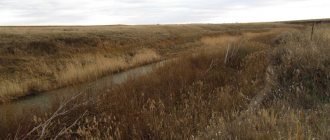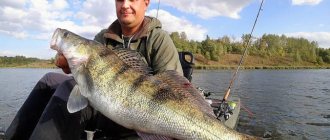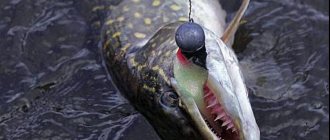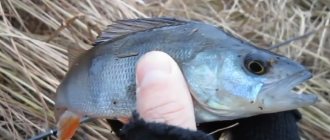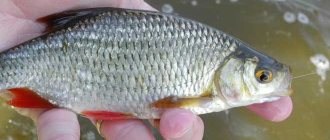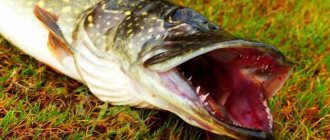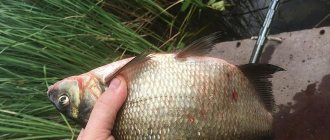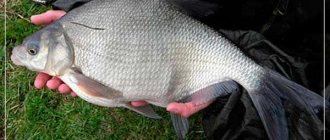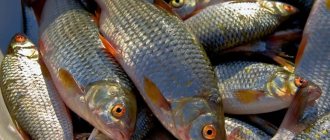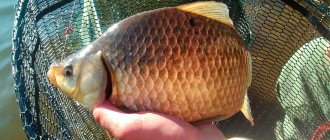Crucian carp is a fish of the carp family. The most common species, living in the Russian Federation, Ukraine and the Caucasus. The main food for fish of this species are insect larvae, mollusks, some types of crustaceans, as well as a variety of aquatic vegetation. A distinctive feature of crucian carp is the high quality of meat, which is why this type of fish is one of the favorite fishing objects.
This guide will fully describe fishing for crucian carp in October-November, because hunting for this heat-loving fish with a float rod in late autumn is considered the most labor-intensive process, requiring special knowledge and skill. Today you will learn about the behavior of crucian carp at a given time, about the correct preparation of complementary foods, as well as what bait you should choose when going for crucian carp at this time of year.
Fishing for crucian carp in November with a fishing rod
Over the past few decades, in our climatic conditions, a sufficient number of common white crucian carp have bred, which, in addition to living in closed reservoirs, also enters both rivers and seaports for the winter. In October, crucian carp sinks closer to the bottom, so you should look for this fish at a depth of three to five meters. Also, the chances of catching crucian carp will increase significantly if you look for it in flowing reservoirs rich in aquatic vegetation, as well as in river bays with a gentle current. If you are going to catch crucian carp in a closed reservoir, then you should stock up on fishing line that matches the depth of the reservoir, since we have already said that crucian carp lies on the bottom in November.
In November, the activity of this fish increases closer to the middle of the day, but only if the weather is quite clear and the sun warms the water sufficiently. In this weather, you will have every chance to tempt the crucian carp with the right bait. In cold and windy weather, catching crucian carp will be possible, but quite difficult.
Another important aspect when fishing for crucian carp is the correctly selected fishing line. Everyone knows that at low temperatures the water in reservoirs becomes more transparent, which is why professional fishermen advise choosing thinner, but at the same time stronger line for catching crucian carp at the end of November, which will undoubtedly increase the efficiency of fishing.
Video
Roach fishing in November. Mouth of the Ros River video
Catching roach in late autumn video
Judging by the forecast, Saturday was my last autumn day for float fishing. Despite the light rain, which started and then subsided, everything else was fine: a slight plus, almost complete absence of wind and a good bite. Probably, the fish, with its sixth sense, also sensed that winter was about to come.
As for the fishing, we can say that it was a success. The roach pecked well and responded well to the bait. Supplementary feeding with a series of three to five balls worked better; after supplementary feeding, the fish stood on the balls for a long time. Supplemental feeding during the day also significantly increased the size of suitable fish; some specimens were truly excellent for a river of this size.
Where to catch crucian carp in November using a float rod
For those who are unfamiliar with all the intricacies of catching crucian carp in the cold season, we will give some practical advice that, we think, will help you in this specific and very delicate matter. Catching crucian carp in November with a float rod can be divided into the food supply of a particular body of water and the number of fish in it. It is precisely by these aspects that you can find a reservoir in which there will be a good bite of crucian carp, well, at least, at least in the fall.
Thus, given that today water bodies are cooling quite slowly, and this is due to global climate change, then fish should concentrate in a certain place. This means that even if you find a reservoir with active fish, you may not catch anything, since you will not know the specific points where the fish gather. Therefore, in order to catch crucian carp in October-November, you should learn some highly practical methods, namely:
Choosing the right reservoir
It is known that crucian carp is a very picky fish, so finding the very body of water in which crucian carp will feed is quite problematic. The best option would be to find a place where only crucian carp live, perhaps next to carp. After all, if crucian carp shares territory with perch, roach or bream, then it will be much more difficult to catch it, even though the accumulation of crucian carp in such a reservoir will be quite decent.
Fishing place
As soon as the temperature decreases, crucian carp, like any fish of the carp family, accumulates at a certain point in order to reduce the energy costs spent searching for food. This suggests that no matter how much you feed a particular place, you will not be able to lure out the crucian carp. The place where the crucian carp has settled should be looked for, leaning on rough vegetation or in holes at the bottom, which can be identified using an echo sounder or a heavy depth gauge. Also, knowledge about the body of water that you can gain by hunting crucian carp in the summer on a specific body of water will undoubtedly help you.
It is very important to remember that crucian carp move from heavily overgrown spots, which usually form in small bodies of water, to a more comfortable place, for example, in a snag. Thus, it would be a good idea to pay attention to those areas of the reservoir where the thickets end and clean water begins, since usually it is in such places that the edge is located.
Weather conditions and time
It is best to go fishing for crucian carp in calm weather or in a weak, warm, not gusty wind. Also, crucian carp will bite well in warm rain, but in this case it should be taken into account that in such weather crucian carp rises from the bottom, up to about thirty centimeters. It is during warm rain that crucian carp become hyperactive, which means that the probability of a bite is very high.
Float rod for catching roach in November
A float rod for catching roach in November is not much different from the summer one. The main point is, of course, the diameter of the main line and leader, which in turn determines the size of the hook and float for a suitable bait.
Rod
Based on this, it is better to take the most sensitive and light tackle. A rod at least 6 meters long is perfect.
fishing line
A main line with a diameter of 0.12 and a leash of about 0.08-0.10 mm. The float should be just as light, with a load capacity of no more than 1.5 grams. Thanks to this minimalism, you can ensure high efficiency of November fishing. But as in any fishing, everything is relative and you should, of course, rely on the place of fishing.
Hooks
Hooks should also not attract unnecessary attention from roaches. For autumn fishing, it is better to use Nos. 3,4,5 (or No. 20-23 of the world classification). In principle, any hooks, even the cheapest ones, will do for this fishing, as long as they are thin and sharply sharpened.
As for the fishing time, the most successful times are morning and evening dawn. But you shouldn’t focus only on this; in the fall, roach, like in the spring, is often well caught in the middle of the day, and indeed throughout the whole day.
What to use to catch crucian carp in November using a float rod
As we have already said, catching crucian carp in November is quite a difficult task, requiring considerable effort and experience from the angler, but if you fish with bloodworms, your chances can increase significantly. As for feeding, each angler has his own composition. But some fishermen with extensive experience in autumn fishing for crucian carp advise against it altogether, since as mentioned earlier, in cold weather crucian carp move in a limited space.
If you have chosen a place, but there has been no bite for a long time, it is useless to wait for some kind of activity. The crucian carp will not come to you, you need to look for it yourself, which means a change of place may bring you good luck. Playing with bait is also strictly not recommended, since crucian carp are inactive in November and will not chase a moving bait. When going for crucian carp, it is recommended to use hooks from two to five, but no less, since there is a high probability of fish disappearing.
Fishing safety in November
When water bodies are frozen in ice, all fishing stops in November until the ice becomes thicker than 5 centimeters. But even with such thickness of ice, you need to be very careful on the pond. You should always walk on ice only after checking its strength. The ice thickness usually increases by 5 mm. per day at a temperature of -10. Remember that even this thickness of ice is dangerous, as underwater currents can weaken it. In addition, clean transparent ice allows the fish to see the fisherman from the depths. Therefore, before fishing, camouflage yourself by scattering straw, reeds around, or darkening the fishing area in any other way.
What is the best time to catch crucian carp in November?
Successful fishing for crucian carp in November is possible at any time of the day, but only if the weather remains stable for several days and there is no strong or gusty wind, otherwise you will be disappointed. As practice shows, at this time of year crucian carp exhibits hyperactivity from early morning until ten o’clock in the afternoon, as well as an hour and a half before sunset and until late at night.
Catching crucian carp in the autumn is quite an entertaining and labor-intensive process that requires special patience and skill. By guessing the place, calculating the time and taking into account the weather, you can get a result that will pleasantly surprise even the most experienced skeptic fisherman.
Spinning fishing in November, on various types of reservoirs, in the regions of central Russia
> How to fish > Angler's calendar > Spinning fishing in November, on various types of reservoirs, in the regions of central Russia
Large rivers and reservoirs
Spinning fishing in November
still produces good catches when fishing in reservoirs. Closer to freeze-up, in such reservoirs there is a significant decrease in the water level, and the main part of the fish is concentrated in the riverbed parts of such reservoirs. However, at this time, predatory fish continue to feed on irrigations with a sufficiently deep depth located next to the riverbed, which is where the predator should be hunted. Such places always give the spinning angler a good chance of successful fishing in any weather.
Mostly perch, medium-sized pike perch and small pike are caught there, but bites happen often. At this time, pike and other predators can be easily caught using both rubber and foam rubber. When the activity of a predator is high, it is best to use stepped wiring to catch it. However, when idle bites become more frequent, the first step is to make the load lighter and fish “drawn” at a very slow speed, pausing and leaving the bait motionless for a few seconds. Usually the predator grabs the bait when it stops or when the bait begins to move smoothly. It is best to catch pike perch or pike perch this way.
The best time to catch predators is in November at the reservoir
, occurs in pits, at the mouths of tributaries, sharp turns of the main channel, in bays. Here you can always catch pike, perch and pike perch using the jig method. And even cold weather is not an obstacle to the bite in such places.
In reservoirs, where the water level remains high even in the pre-winter period, the picture is somewhat different. Here the predator is almost evenly distributed throughout the water area of the reservoir. However, on the deep edges of such reservoirs, medium-sized pike and perch are caught quite well, and sometimes pike perch are caught. The most successful fishing at this time occurs in the afternoon, during periods of stable weather.
As for large rivers, fishing here in November is quite difficult. There is instability in the bite or it is generally very weak. It takes a lot of effort to catch a predator. But if the weather is stable enough, fishing can be quite successful. The main fishing option here is also jig, although there are other options.
For example, in a river like the Oka in the pre-winter period, pike perch, mostly weighing about 1 kg, can be caught well in some areas. And at dawn you can even count on catching individuals weighing from 3 to 6 kg. Usually they look for pike perch there on rocky dumps and catch them with actively vibrating flat wobblers. In the morning and in the evening twilight, the fanged one prefers baits with a bright lemon-colored belly, and in the daytime, silver-blue baits work better.
It is also possible to catch bream in the rivers in November using a spinning rod,
for small spinning lures made of foam rubber. Mostly individuals weighing 0.6-1 kg are found. In this case, many idle bites occur. Particularly good catches of bream occur in areas where wintering pits are located. In this case, miniature baits made of foam rubber are mainly used with minimal loading.
Small deep rivers
Fishing in November with a spinning rod, on small rivers
, on clear and stable weather days it is especially successful for perch. During this period, small and medium-sized perch concentrate in deep pools and holes. And if the angler knows the location of such places, all he has to do is fish them one by one. It is quite possible to catch 5-10 individuals from each point. The largest concentrations of the striped predator occur in the lower reaches of rivers and in estuary areas. Often, in addition to perch, small pike can grab the bait in such places.
The most preferred bait for fishing in small rivers is a medium-sized twister paired with a light jig head. Usually during this period, on small rivers, baits painted in pearlescent and white tones are used, but often yellow bait with interspersed glitter or lemon-colored bait becomes catchy. However, when the striped one is active, then almost any color bait will do.
In late autumn, on small rivers with great depths, as a rule, the slowest retrieves are used, with dragging along the bottom and long pauses.
Lake-type reservoirs
Despite the fact that in lakes and other stagnant bodies of water, the water cools quickly, the toothy predator bites there, although with varying success, but constantly. Pike fishing in lakes in November
, no less promising than in early autumn. Pike actively feed even in cold November water. There are often bursts of activity. In a lake-type reservoir, the main task of the spinning rod is to find a predator and provoke it to bite.
On lakes and dams, it is necessary to carefully check the depths and places with an abnormal bottom. This is where most fish, including predatory ones, are concentrated. At the same time, all those baits and methods of placing them that were used in October remain relevant. The easiest way to tempt a perch is with a small rubber with a light weight. In this case, the bait should be drawn by dragging along the bottom. This is the only way to achieve the maximum number of bites. In the case of pike, you should primarily use slow-playing wobblers and spinners.
Before the freeze-up, there was also successful fishing for predatory fish using a spinning rod in November.
, often occurs in small lakes branched off from the main body of water. And often an unsuspecting spinning angler in such a place can get a stunning bite. In such toad beds, all the grass has died and sank to the bottom, and the pike is actively moving there in search of prey. And in reservoirs cut off from the main rivers (floodplain and oxbow lakes), the predator eats almost all the fish, and the hungry rushes about the entire water area.
If ice appears on a reservoir and then melts due to weather conditions, outbreaks of very active biting often occur. It can continue until the reservoir is completely covered with ice.
In small flood lakes, which are connected to each other and large bodies of water by channels, the situation is somewhat different. A large number of fish come here to spawn, and if the water level there is constant and there is a lot of food, then the fish stay there almost until the ice forms. And only the coming freeze-up contributes to the departure of peaceful fish and predators from such “habitable” places. The fish sense that ice is about to begin and accumulate at the entrance to the channel, and then suddenly almost all of them immediately go down the channel into the mother river or into a large lake. And from such a catchy place you can get good catches for several days.
In dammed and relatively deep reservoirs, perch and small pike, as a rule, accumulate on dumps in a narrow strip of the flooded river bed at its bends. And often the concentration of a small predator in such places can be so dense that bites occur on almost every trip. Small vibrating tails and twisters are used for this.
Happy fishing!
Published: November 23, 2017
Other interesting materials:
| May fishing in Norway If you don’t yet know where to go fishing during the May holidays, then... | Gulf of Finland - Maps of reservoirs - From Leningrad to Kronstadt Baltic Sea, Gulf of Finland... | Autumn catfishing Fishing for catfish in the fall is an exciting, but not an easy activity, on… | Peculiarities of winter fishing in snags. Snags are one of the most promising places for fishing.... |
Catching different types of fish in November
Each fish has its own method of fishing, they all respond differently to bait gear and live in different places in the reservoir. In November, you can catch the following fish with a spinning rod: pike, perch, pike perch, catfish, bersha, chub, burbot, trout and salmon. These are the most basic types of fish that are often found in reservoirs in November.
Perch. In November, perches are found in large schools and are found at great depths in the reservoir; to catch this fish, you should use a wobbler, jig, or spinner bait. The best time to catch perch is in the morning or evening, before sunset. Perches love warm, sunny weather, so it’s best to catch them when there are sunny days and bodies of water without currents or waves.
Zander. You won’t find pike perch in one place of the reservoir; they constantly cruise throughout the entire depth in search of food. Most often they are found in places where there is great depth and a lot of small fish. During the daytime, pike perch do not move very actively around the reservoir, so it is better to catch them in the morning or evening, when the sun has not yet set. As bait for pike perch, use a jig or donka, since pike perch is a fairly large fish, the bait must be strong.
Pike. This fish lives in all fresh water bodies, there is always a lot of it, it is large in size and is very popular with anglers. A pike bite is always marked by a good bite, especially in the autumn season; pike loves to eat, so it responds well to bait. You can use any bait; large spoons and live bait are especially good.
It is better to catch pike in the morning and evening when the sun shines brighter.
In November, the pike swims far from the shore and very deep, since all the small fish with the onset of cold weather go deep into the reservoir, the pike also has to stay in these places.
The best time for fishing is the period when there is no ice on the reservoir, and frost has already appeared. This period is short-term and can last from 1 to 10 days, depending on the volume of the reservoir.
It was also noted that the pike bites well on days of bad weather, the atmospheric pressure rises, and the pike begins to actively bite.
Lures for pike fishing in November are chosen in large sizes, since the fish are hungry during this period. The largest pike trophies are caught in November.
